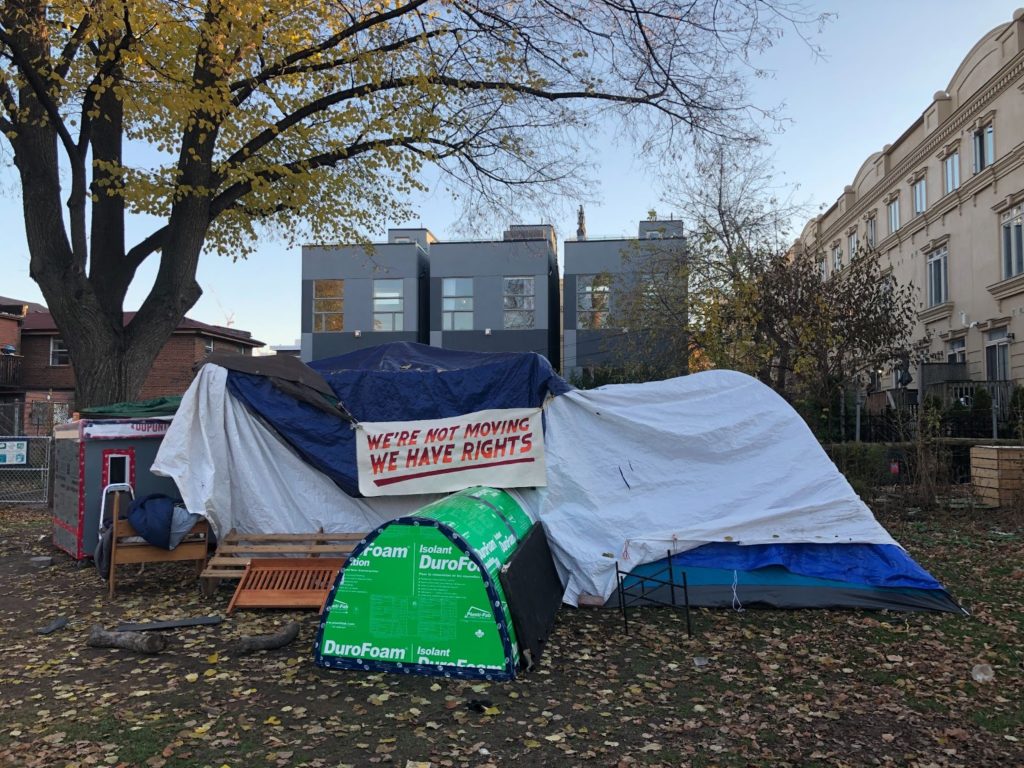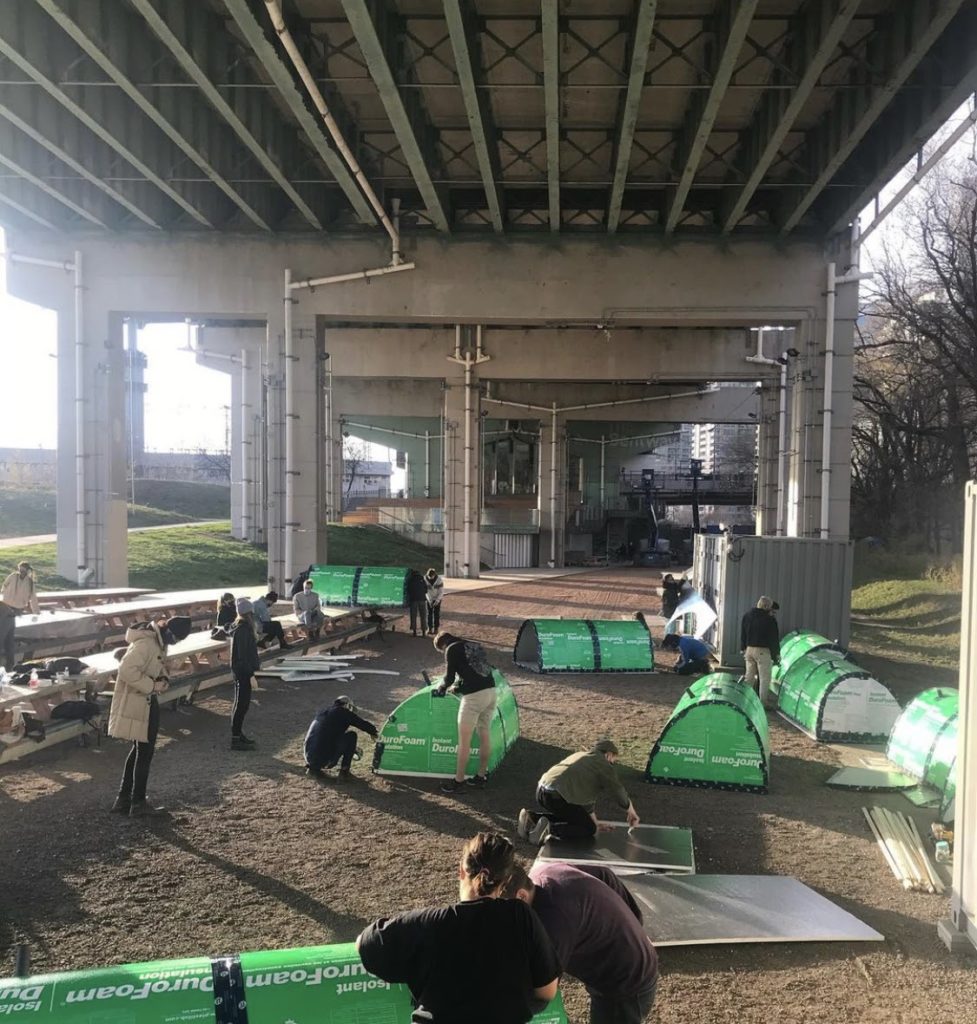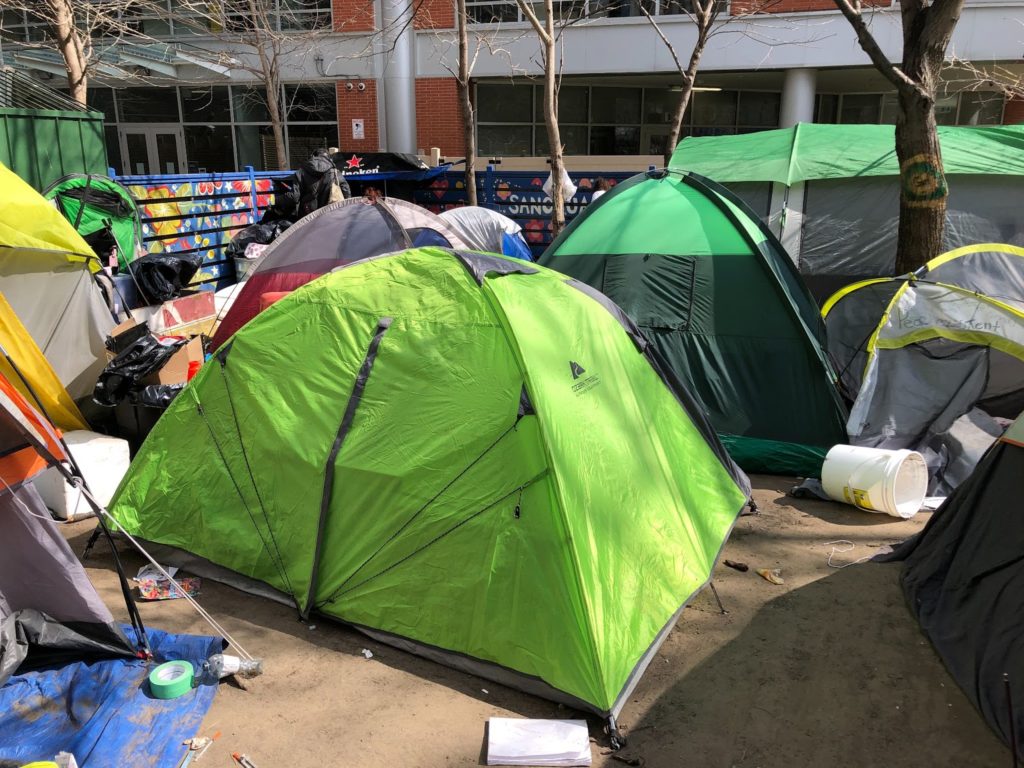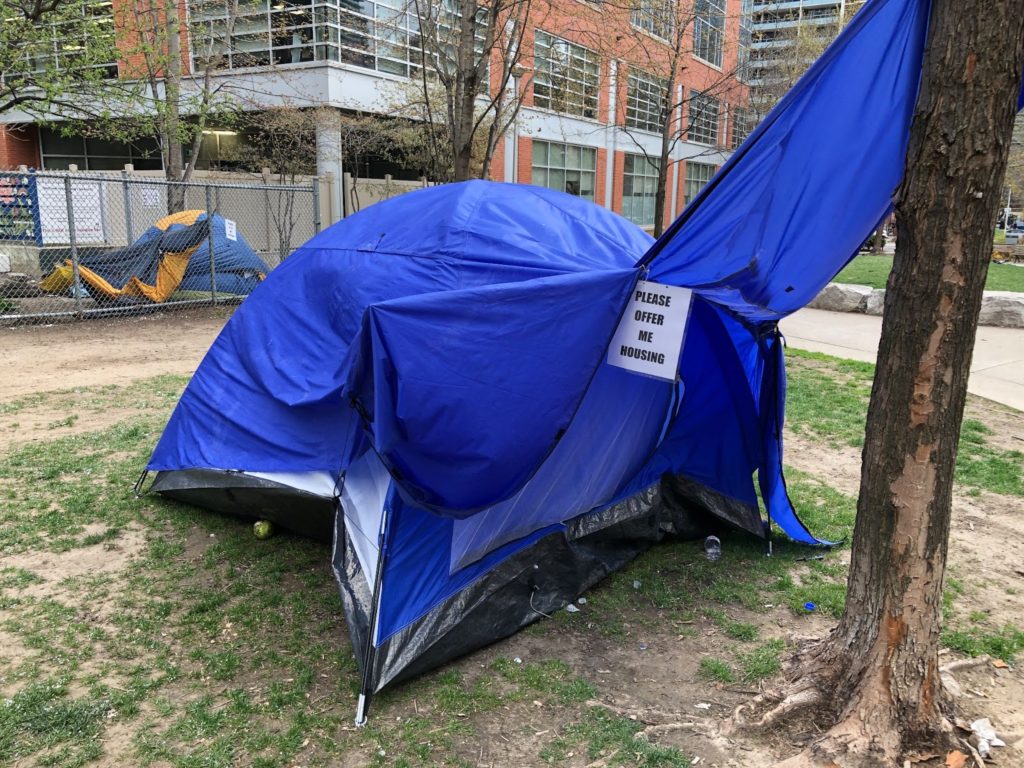The pandemic prompted a sharp increase in homelessness rates, but advocacy groups say the city has spent the year doing more attempting to erase the problem from the public eye than solve it

On Feb. 14, Jennifer Jewell felt certain she was going to die.
It was 11 p.m. when the 50-year-old Toronto resident, who is currently experiencing homelessness, heard the fire alarms start to go off at the Bond Place Hotel in downtown Toronto. The building had been serving as a temporary shelter during the COVID-19 pandemic.
Jewell has multiple physical disabilities which make evacuating her 15th floor room via the stairs a physical impossibility without help.
She called security and the front desk over and over, telling them she was trapped in her room but only one person came. When Jewell told them she couldn’t navigate the stairs with her walker, they left. She was alone.
When smoke began to seep into her room, she decided to call 911. As she waited, Jewell says the air became increasingly suffocating. She felt panicked. Jewell began to send voice messages to her loved ones. She took to Twitter to write out what she thought could be her final moments.
“I really thought I was going to die,” said Jewell.
Fifteen minutes after she made the call, two firefighters with oxygen masks were at her door.
Plagued by nightmares, Jewell hoped — at least — her near-death experience would change how the temporary shelter was being run. It didn’t. It was only after she shared her story with reporters that she felt the city started to pay attention.
Going public wasn’t a decision made lightly, said Jewell. “I finally realized this was about more than me and decided to fight.”

The pandemic prompted a sharp increase in homelessness, but advocacy groups say the city spent the year doing more to erase the problem from the public eye than solve it. They say the city fixated on moving people into “safe” indoor spaces — a move these advocates claim is more about emptying parks than keeping the unhoused safe. As a result, volunteers have had to step up to help the thousands of people who, like Jewell, have no place to call home.
At latest count, the city estimates at least 7,745 people are currently experiencing homelessness. The shelter system only has the ability to house 5,740 people, meaning there are at least 2,005 more people who are homeless in Toronto than there are shelter spaces.
But advocates say that number is flawed because the city doesn’t count properly. Their system only tracks people who have used the shelter system at least once in the past three months and didn’t move to permanent housing. Advocates estimate that there are at least another 1,000 unhoused people who aren’t reflected in the city’s numbers, and they believe around 900 of those people are living in encampments.
The city has called these encampments “not safe and not legal” and has been adamant about moving residents into the shelter system.
But since the onset of the pandemic there have been 1,454 cases of COVID-19 in the shelter system, and eight deaths. So far this year, to April 19, there have been four hospitalizations and one death — and there are currently 306 active cases.
That’s why, for many, encampments are the safer option.
Lorraine Lam, outreach co-ordinator at Sanctuary Toronto, said the city has framed living in encampments as a choice for many, when that is far from the case.
“When your option is to be (either) at a COVID-ridden shelter or be outside where you don’t get sick, that’s not really a choice to me,” said Lam.
Lam said the existence of these encampments is visible proof that the city has failed to help the unhoused. And so are the positive COVID-19 cases and outbreaks in the shelter system.
“At the end of the day, optics are very important to the city, so god forbid it gets out that this is being poorly managed.” said Lam.
Lam isn’t the only advocate concerned with the city’s lack of initiatives for keeping residents in shelters safe. In January, members of multiple advocacy groups reached out to the Shelter Support & Housing Administration (SSHA) about an outbreak at Seaton House, affecting 43 clients and staff on Jan. 21. They asked for mass testing to be conducted at Seaton House.
On Jan. 28, the members received a response stating that the testing was being “skillfully managed” by the team at Seaton House and that “mass swabbing has been underway for the past several weeks as a part of contact tracing and outbreak management” when discussing shelter outbreaks.
Lam says testing was not immediately introduced until cases began to spike.

“Two weeks after the end of January, we saw the numbers jump exponentially…that’s when (the city) decided to do testing at Seaton House,” said Lam.
In an email with the Ryersonian, city spokesperson Kris Scheuer didn’t directly respond to this claim but that repeated testing is being conducted in shelters every three to five days.
Scheuer added that there are measures that are being immediately implemented to “enhance the protection of people experiencing homelessness as a result of these developments and in response to updated public health guidance.”
He described the measures as: “Enhanced Personal Protective Equipment (PPE) protocols – updated directive on eye protection for shelter staff and three-layer masks for clients, limiting movement between shelters, exploring implementation of rapid testing pilots, guidance for improvements to indoor air quality and continued vaccination rollout planning.”
While outbreaks at shelters continue to rise, for people finding safety in encampments more issues have emerged over the past couple months. Last year while the city was rushing to open additional shelter spaces, Toronto carpenter Khaleel Seivwright began building small, insulated wooden shelters to protect homeless people during the winter.
These tiny shelters were designed to be a temporary housing solution for people who were unable to obtain a shelter bed, or who felt unsafe staying in the shelter system. Yet on Feb.19, the city released a notice announcing that an injunction had been filed against Seivwright, which called for him to cease the building of tiny shelters and “illegally depositing them on city property.”
When she was staying in Dufferin Grove Park, Jewell herself was an occupant of a tiny shelter for several weeks, a shelter she says she felt the most safe in. She says the decision to file the injunction is just the latest example of the city failing its most vulnerable people.
“They’ve said publicly that they are only clearing abandoned camps, yet they have been filmed removing and destroying people’s tents and shelters while (they were) still living in them,” said Jewell. “Time and time again, they’ve been caught in lies, and it’s killing people.”
According to Scheuer, since last April to April 23, 2021 “at least 145 people have taken the city up on its offer of safer indoor space including shelters, hotel programs and housing.
“As well, city staff have engaged with those at the four sites — Moss Park, Alexandra Park, Trinity Bellwoods and Lamport Stadium — to have conversations about what people are looking for and how the city can help,” said Scheuer. “At these four sites, there is a schedule of services that city staff and partners have when they are at these sites to have conversations and offer support.”
However, Alykhan Pabani, an outreach worker at the Encampment Support Network, a volunteer-run collective supporting people living in Toronto’s encampments, said that throughout the pandemic the city has been hesitant to speak directly with people experiencing homelessness. Instead they’ve been in contact with advocacy groups, whom they’ve repeatedly told that their aim is to clear the encampments. (The city didn’t respond to Ryersonian’s request for comment on these claims.)
The only time the city did send out a representative to speak with encampment residents, Pabani says, was done under false pretences, since that very same day they’d file the injunction against Seivwright.
While no court date has been set, Lam says the injunction has broken what little trust was left between advocacy groups and the city.
“It’s been a huge, huge fight,” she said. “When the city put the injunction notice out, a lot of us felt like they were very clearly declaring war on the poor, because they have been so reluctant to actually work in collaboration with people who are vulnerable.”
A recent Ontario study found that when compared to Toronto’s housed population, individuals who have been recently homeless are over 20 times more likely to be hospitalized for COVID-19, over 10 times more likely to require intensive care, and over five times more likely to die within 21 days of a positive test.
Cathy Crowe is a street nurse who’s been working with the city’s homeless population for over 30 years. She says that rather than attempting to criminalize tiny shelters, the city needs to see the bigger picture as to why people feel safer living in them.
“Given the choice of a dormitory room in a shelter where a COVID variant is aggressively stalking its victims or an alternative like a tiny shelter with a lock on the door, I know what I would choose,” said Crowe.
Even if encampment residents are willing to accept the risk of COVID-19 by going inside, advocates say they then have to contend with isolation — something they believe is tied to an increase in overdoses.

Crowe says the number of overdose deaths in hotels and shelters is “staggering.” Back in September she spoke with an agency worker who told her that there were 10 overdose deaths in the shelter that the worker was aware of.
Pabani says the city needs to show compassion towards encampment residents rather than being so fixated on erasing their footprint in parks.
“People are choosing from the best of really bad options. If you’re outside in the cold in the middle of winter, you’re going to try to do whatever you can to keep yourself from freezing,” he said.
In addition to being disabled, Jewell is immunocompromised and unable to live in a congregate shelter setting, so she knows first-hand that the city’s “safest option” of getting unhoused people out of encampments and into shelter spaces isn’t feasible for everyone.
“Even without COVID-19, my doctor of 20 years told me that I’d be safer living outside,” said Jewell. “It’s very isolating here, especially compared to the park. I miss the park, I miss the community that gathered around us.”
In March the city introduced a new program designed to provide “safe, inside space to people living outside, but advocates say it’s just a repackaging of their past attempts to coerce people who may not want to go inside into these spaces by attempting to criminalize encampments.
The program, known as the Pathways Inside Program (PIP), aimed to relocate people living in four of the city’s largest encampment sites — Moss Park, Lamport Stadium, Trinity Bellwoods and Alexandra Park — into a new temporary shelter space located at the Novotel Toronto Centre Hotel. Days after the program was announced they began handing out Notices of Trespass, giving encampment residents a deadline of April 6 to either accept a space at Novotel or be forced to clear their belongings. It’s now been a month since those notices were distributed and the city says that over 60 people have accessed a shelter space through PIP.
But advocates say the protocol to secure a space at Novotel has been unnecessarily complicated. Pabani says that for the most part, only those who have “a footprint” — meaning a tent or tiny shelter — in the four priority encampments and who haven’t accessed the shelter system in the past 30 days qualify for a space at Novotel, rather than simply anyone looking for safe indoor shelter.
“What makes this program different is that the city is not really hiding their intentions,” said Pabani. He believes that this initiative is more about clearing the parks in time for warmer weather than it is about providing access to safe shelters. However, the city said it was about health and safety concerns, according to NOW Magazine.
According to the city, they stated that they “established the PIP program to assist those living in four encampments…to provide the support (the unhoused) need to come inside and, ultimately, find permanent housing.”
However, Lam also finds the timing suspect.

“Since Novotel opened (at the) end of February, I have been trying to refer people,” said Lam. “Some elderly, some ride the TTC overnight, some in parking garages and stairwells. Colleagues tried to refer people with major health concerns; all have been rejected.”
On March 23, ESN shared an audio clip of an unknown individual calling Streets to Homes (STH) regarding the placement of an unhoused person into a shelter. During the clip, the representative from STH stated that Novotel was full, and the unhoused individual would have to call Central Intake to access another shelter.
The representative also mentions that due to the unhoused person already having accessed another shelter prior to requesting access to Novotel, they would not be able to be housed at Novotel.
“He got out of prison three weeks ago and then went to a respite a couple of nights,” said the caller. “So that prohibits him from entering Novotel?”
“Yeah, because he’s accessed a space within the last 30 days,” said the representative.
“What’s the logic there?” asks the caller.
“Those are the referral requirements that were established,” said the representative.
The city currently lists Novotel at 48.8 per cent occupancy, with 105 rooms vacant. (The city did not respond to the Ryersonian questions on who actually qualifies for a shelter space there.)
But just two weeks after the city announced PIP, Novotel experienced a COVID-19 outbreak. As a result, Toronto Public Health stopped the shelter hotel from accepting any new residents, which forced the city to backtrack on its plan to start enforcing the trespassing bylaws on April 6.
Those who had already moved from encampments to Novotel weren’t notified about the outbreak until three days later, and were told mass testing wouldn’t begin for almost a week. Meal services have already gone back to the lobby, a move that leaves advocates fearful of further spread.
While the city has now stated that it has no plans to enforce encampment evictions, advocates still remain fearful that these plans have only been temporarily paused rather than scrapped entirely.

To Pabani one of the most disheartening aspects of the city’s response has been the failure to grasp that people living in encampments often do so for the sense of community — something the shelter system currently lacks.
“(Residents) like each other and talk to each other and hang out with each other, they’re each other’s life supports,” said Pabani. “If someone is overdosing, they’re not going to count on some city agency or the police to come by and revive (them) in the shelters.”
Pabani said that if it wasn’t for the help of community members doing free labour, donating and offering humanitarian aid, people wouldn’t have survived the winter. Moreover, the large amount of support for ESN’s campaign to halt encampment evictions has also been “extremely helpful.”
“I think the public support is rising,” said Pabani. “It’s inspiring to see people come together.”
On April 5, over 300 health-care providers wrote an open letter calling on the city to end all encampment evictions. They join many advocates in making it clear that displacing and criminalizing those living in encampments isn’t a solution to the city’s housing crisis — especially in the midst of a global pandemic.
If the city is serious about keeping people experiencing homelessness safe, Crowe suggests mass screening and testing at shelters, employing rapid tests, prioritizing vaccinations and leasing more hotels as spaces to reduce crowding in shelters. Restricting sleeping arrangements to one person or family per room, would also help, she says.
It’s advocates like Crowe who’ve kept Jewell going. Her message to the city is simple: start listening.
“Listen to the people living outside and within (the) shelter system, the social workers and street organizations that have decades worth of experience,” Jewell said. “They need to start building truly safe, accessible and affordable housing close to community support.”
